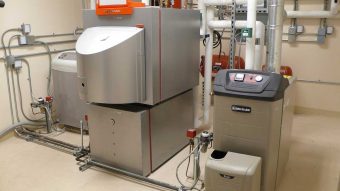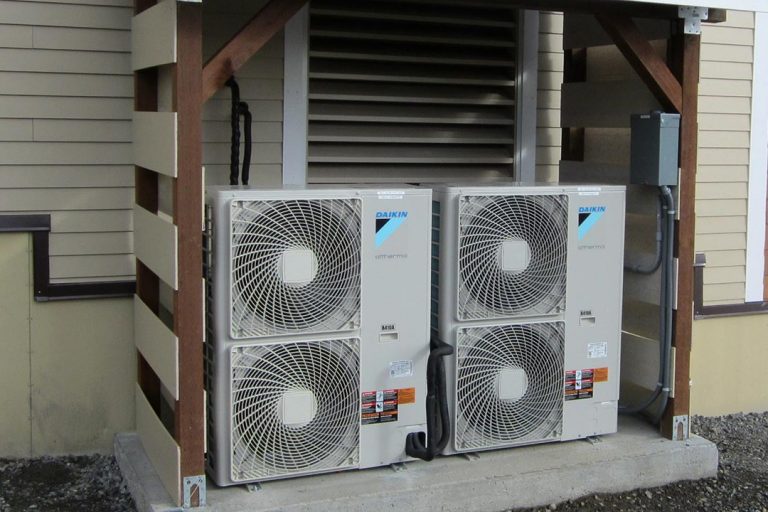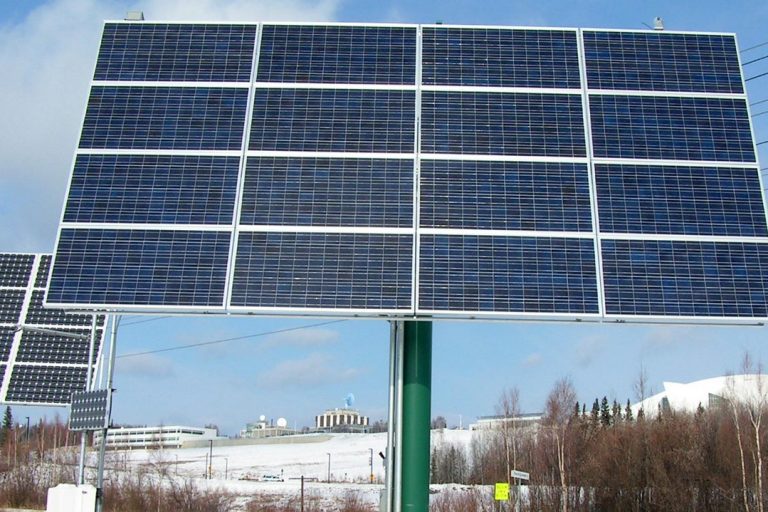Solar
The world’s northern latitudes offer a unique opportunity for solar energy. While we have little to no sunlight in the winter months, we have an abundance in the summer. With the high cost of electricity and the growing impacts of climate change, solar power offers a clean solution to providing energy to our homes.
There are two primary ways to use solar energy: solar photovoltaic panels, which generate electricity, and solar thermal collectors, which generate heat for space heating or domestic hot water. While they both turn sunlight into energy for your home, they have very different applications. Considering your site conditions and heating, plumbing, and electric systems will help determine if one (or both) technologies would work for you.
What’s the difference?
Solar thermal, or solar hot water, collectors absorb heat from the sun and transfer it to water or glycol to provide space heating or domestic hot water. The two most common types are flat-plate collectors and evacuated tubes, flat-plate collectors being the most dominant. They generally consist of a 4×8-foot glass-encased panel that contains a thin metal sheet, with a dark coating to absorb energy.
Beneath the sheet are coils filled with heat-transfer fluid. Fluid circulates through the tubing, absorbing heat and then transferring it to a storage tank. A typical residential system used to supplement domestic water heating includes two panels.
An evacuated tube collector contains several rows of glass tubes connected to a header pipe. Each tube is a vacuum, which acts like a sealed thermos and eliminates heat loss through convection and radiation. Because of this, evacuated tube collectors lose less heat to the environment than flat-plate collectors.
A small copper pipe filled with fluid (glycol, water, or some other antifreeze) runs through the center of the glass tube. The fluid heats up, vaporizes, rises into the header pipe, and transfers heat (through a heat exchanger) to another pipe filled with fluid. This fluid carries heat to the water tank. From there, water can be used for hydronic heating and domestic hot water or converted for other uses.
Solar Power
Solar photovoltaic (PV) panels convert sunlight into electricity. They have a silicon sheet made up of semiconductors. When light strikes the sheet, part of the energy is transferred to the semiconductors, which knocks electrons loose and allows them to flow freely through connected wires. This flow of electrons is called direct current (or DC). The current then flows into an inverter, which changes it into AC (alternating current), the power used by your appliances. If there is no immediate demand in your home, this power can be stored in a battery or returned to the electric grid.
Cold Climate Specifics
Alaska is a rather unique place for solar energy because of the excessive summer sun and the virtual darkness in winter months, which means a few months a year where solar doesn’t contribute much. For example, the 12-kilowatt photovoltaic array at the Cold Climate Housing Research Center in Fairbanks produces more than 10,000 kWh from March-September (about 30 percent of the building’s electric demand) but only 1,833 kWh during the rest of the year.
Most residential solar thermal systems are used to offset primary heating sources. If you want to use solar thermal as a main heating source, you need some type of seasonal thermal storage system to bridge winter months. PV systems, in most cases, simply offsets electricity purchased from the grid.
With PV, you can produce more power from your panels year-round if you keep them free of snow and change the tilt angle twice a year. The most productive months for CCHRC’s panels are April and May, when they enjoy long daylight hours and also capture reflected solar gain off the snow cover.
Different types of solar thermal panels perform better at different times of the year. For instance, evacuated tube collectors produce more BTUs during the spring and fall shoulder seasons, while flat plate collectors produce more heat during the summer.
Which ones are better to install?
To figure out which is a better investment, you need to consider what your installation costs would be and compare them to your current heating and electricity prices. Let’s look at an example Fairbanks house.
A 1,000-watt PV array will produce about 1,000 kWh a year in the Interior. Assuming electricity prices of 20 cents a kilowatt-hour, that would save you $210 a year. A two-panel solar thermal system could produce roughly 7 million BTUs a year, offsetting either 54 gallons of oil (saving ~$150 at $2.50 a gallon) or 2,050 kWh of electricity (saving $410). In other words, homeowners with electric water heaters stand to save more from solar thermal than those heating with other fuel types.
The actual cost of solar thermal in Interior Alaska (roughly $2.50 per watt over the lifetime of the system) is lower than solar photovoltaic (less than $4 per watt as of June 2019). Yet PV panels are still more common in Fairbanks largely because they are easier to install and retrofit, don’t require plumbing, don’t have to be integrated into existing mechanical systems, and have no moving parts (whereas solar thermal systems have fluid and pumps that must be replaced).
Solar thermal systems will also shut off once your hot water tank is hot, whereas solar electric will power the electric hot water heater up to 8 months of the year, and will continue to produce energy to offset other electrical loads even when the hot water tank is hot, thus always providing peak efficiency.
The actual output and cost of your system will depend on many factors, like the solar exposure of your particular site, the type of heating or hot water system, the type and number of heat exchangers required, and others. With the cost of solar constantly dropping and fossil fuels always in flux, solar is becoming an increasingly attractive long-term investment. Anyone with good solar access may be wise to consider these systems as an option.
Solar at CCHRC
We have two types of solar installations at CCHRC. Our solar photovoltaic system consists of a 10-kilowatt array that is tied to the grid to offset our electric use. The system provides the equivalent of approximately 15% of our power over the course of the year and paid for itself in approximately 9 years.
Solar data can be seen here: Check current solar data at CCHRC here.
An economic analysis of the system can be found below.
We also have a solar hot water collectors that provide heat to the building and charge a tank of water so we can store heat when it’s not immediately needed. Read more about it on our Thermal Storage page.
Related Resources
| Title | Resource Link |
|---|---|
| Alaska Center for Energy and Power | |
| Solar Design Manual for Alaska | |
| Solar Hot Water Heating for Your Home Snapshot | |
| Solar Photovoltaics Economic Analysis | |
| Solar Photovoltaics for Homes Snapshot |











